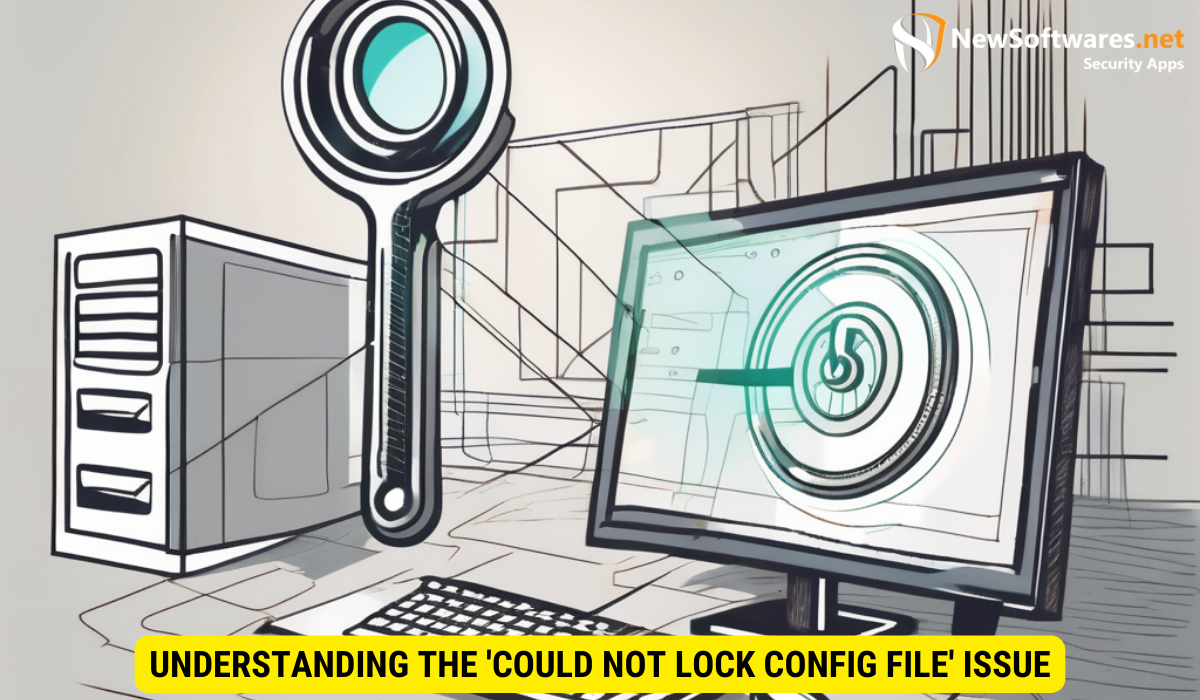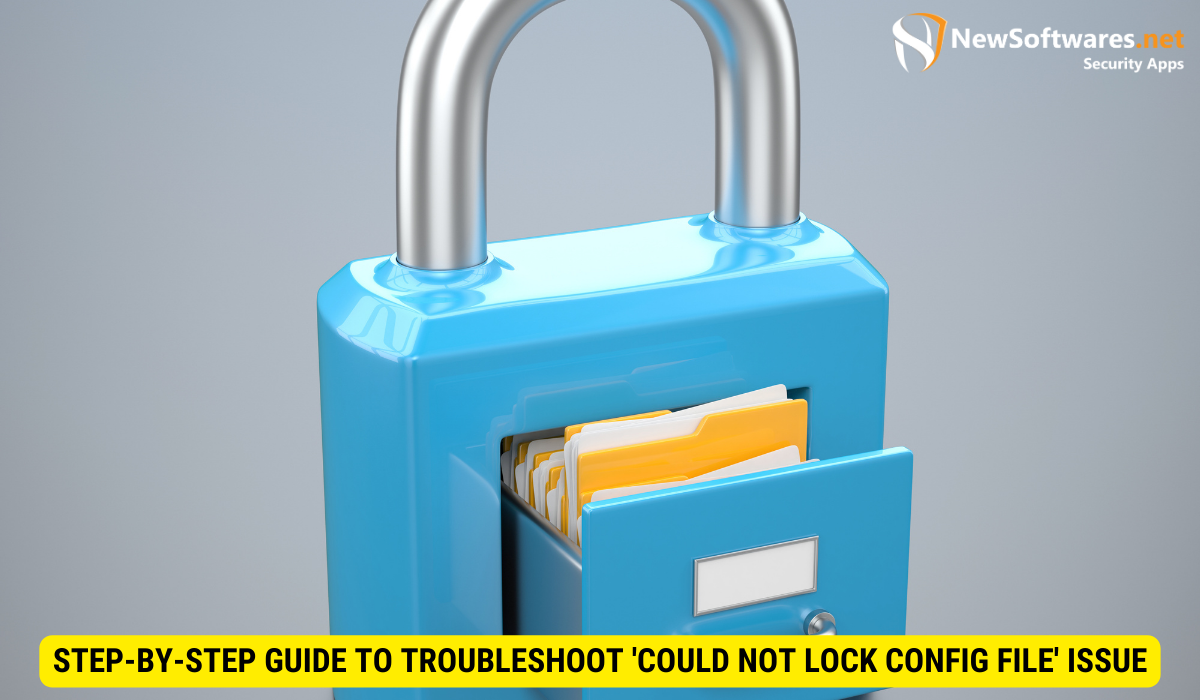The “Could Not Lock Config File” issue in system management arises when a configuration file is locked by another user or process. To address it:
-
Understand the role of config files.
-
Implement preventive measures like limiting access and using version control.
-
Follow a step-by-step troubleshooting guide.
-
Ensure smooth recovery and restoration post-resolution.
-
Adopt long-term strategies such as regular maintenance and utilization of configuration management tools.
In the world of system management, one common issue that administrators often encounter is the dreaded “Could Not Lock Config File” problem. This error can be frustrating and disruptive, as it prevents system administrators from making changes to important configuration files. I will explore the causes of this issue, preventive measures to avoid it, step-by-step troubleshooting techniques, recovery and restoration after resolving the issue, and long-term strategies for managing configurations.
Understanding the ‘Could Not Lock Config File’ Issue

Before diving into the troubleshooting process, it’s important to understand the role of config files in system management. Config files contain vital information and settings that dictate how a system operates. They are often used to configure various aspects of software applications, operating systems, and network devices.
However, when multiple users or processes try to modify a config file simultaneously, conflicts can occur. One such conflict is the “Could Not Lock Config File” error, which arises when a file is already locked by another user or process, preventing any further modifications.
The Role of Config Files in System Management
Config files are the backbone of system management. They serve as the central repository for storing important settings and configurations used by various software and hardware components. Without config files, systems would lack the necessary instructions to function properly.
Config files can range from simple text files to more complex structures, depending on the system or application they are associated with. These files act as a blueprint that dictates the behavior of a system, ensuring consistency and stability across different environments.
For example, in a web server environment, the config file may contain settings related to the server’s port number, document root directory, and security configurations. These settings determine how the server handles incoming requests, where it serves the requested files from, and what security measures are in place to protect against malicious attacks.
Common Reasons for Config File Locking Issues
There are several common reasons why a config file may become locked, leading to the “Could Not Lock Config File” error:
- Concurrent editing: When multiple administrators or processes attempt to modify the same config file simultaneously, conflicts can occur. This often happens in environments with multiple system administrators or during automated configuration management tasks.
- Inadequate file permissions: If the user attempting to modify the config file does not have the necessary permissions, the file may become locked. This can be caused by incorrect ownership or file permission settings.
- File open in another application: If the config file is open in another application, such as a text editor, it may become locked. This can happen if a user forgets to close the file after editing or if another application automatically opens the file for monitoring purposes.
- System resource limitations: In rare cases, system resource limitations, such as a shortage of file locks or excessive disk usage, can lead to config file locking issues.
Understanding these common reasons for config file locking issues can help in troubleshooting and resolving the “Could Not Lock Config File” error. By identifying the root cause, system administrators can take appropriate steps to prevent conflicts and ensure smooth operation of their systems.
Preventive Measures to Avoid Config File Locking
While it’s not always possible to completely eliminate config file locking issues, there are several preventive measures that system administrators can take to minimize their occurrence:
First and foremost, adhering to best practices for config file management can greatly reduce the likelihood of encountering the “Could Not Lock Config File” error. By following these best practices, system administrators can ensure smoother operations and minimize disruptions:
Best Practices for Config File Management
1. Limiting access: Restricting access to config files only to those who absolutely need it can help prevent conflicts caused by concurrent editing. By granting access only to authorized personnel, the chances of multiple users attempting to modify the same config file simultaneously are significantly reduced.
2. Implementing version control: Utilizing version control systems, such as Git or Subversion, can provide a structured approach to managing config files, enabling rollbacks and facilitating collaboration. With version control, system administrators can easily track changes made to config files, revert to previous versions if necessary, and collaborate with other team members without the risk of file locking issues.
3. Regular backups: Creating regular backups of config files ensures that the system can be restored to a working state in the event of unexpected issues. By having backups readily available, system administrators can quickly recover from config file locking problems and minimize downtime.
Importance of Regular System Updates
In addition to implementing preventive measures for config file locking, keeping the system and associated software up-to-date is crucial for maintaining stability and security. Regularly installing updates helps resolve known issues and minimizes the likelihood of encountering config file locking problems.
Regular system updates not only address bug fixes and security vulnerabilities but also provide enhancements and optimizations that can improve the overall performance of the system. By staying up-to-date with the latest updates, system administrators can ensure that their systems are equipped with the necessary tools to handle config files efficiently and avoid potential locking issues.
Furthermore, staying current with system updates demonstrates a proactive approach to system maintenance and security. It showcases the commitment of system administrators to provide a stable and secure environment for users, minimizing the risk of config file locking problems and other related issues.
Step-by-Step Guide to Troubleshoot ‘Could Not Lock Config File’ Issue

When faced with the “Could Not Lock Config File” error, the following step-by-step guide can help system administrators pinpoint and resolve the issue:
Initial Diagnostic Steps
1. Check for any running processes or users that might be accessing the config file.
2. Verify that the user attempting to modify the file has the necessary permissions.
3. Restart the application or service associated with the config file to release any locks.
Advanced Troubleshooting Techniques
1. Perform a system-wide search for any processes or applications that might be holding locks on the config file.
2. Temporarily disable any applications or services that could be interfering with the locking mechanism.
3. Investigate system resource limitations, such as disk space or file lock limits, which could be causing the issue.
Recovery and Restoration After Resolving the Issue
Once the “Could Not Lock Config File” issue has been resolved, it’s important to follow these steps to ensure a smooth recovery and restoration process:
Restoring System Settings Post-Troubleshooting
1. Verify that the config file has been successfully modified without any unintended changes.
2. Restart any affected applications or services to apply the updated config file settings.
Ensuring Smooth Operation After Issue Resolution
1. Monitor the system closely to ensure that the error does not reoccur.
2. Implement any necessary preventive measures, such as adjusting file permissions or revisiting best practices for config file management.
Long-Term Strategies for Managing Configurations
To effectively manage configurations and minimize the risk of encountering the “Could Not Lock Config File” issue in the future, consider implementing the following long-term strategies:
Regular Maintenance and Monitoring
1. Implement regular maintenance tasks, such as periodic review and cleanup of unused config files.
2. Set up proactive monitoring systems to alert administrators of any config file locking issues or abnormalities.
Utilizing Configuration Management Tools
1. Consider adopting configuration management tools, such as Ansible, Puppet, or Chef, to automate the management and deployment of config files.
2. These tools offer features like centralized configuration storage, version control, and automated deployment, which can greatly simplify the config file management process.
Key Takeaways
- Config files play a crucial role in system management, containing important settings and configurations.
- The “Could Not Lock Config File” issue arises when a config file is locked by another user or process.
- Common reasons for config file locking issues include concurrent editing, inadequate file permissions, and file open in another application.
- Preventive measures such as best practices for config file management and regular system updates can help avoid config file locking issues.
- A step-by-step troubleshooting guide, along with advanced techniques, can assist in resolving the “Could Not Lock Config File” issue.
FAQs
What are config files?
Config files are files that contain important settings and configurations used by software applications, operating systems, and network devices.
Why do config files become locked?
Config files may become locked when multiple users or processes attempt to modify them simultaneously, leading to conflicts.
How can I prevent config file locking issues?
To minimize config file locking issues, you can limit access to config files, implement version control, and regularly update your system.
What are some advanced troubleshooting techniques for the “Could Not Lock Config File” issue?
Advanced troubleshooting techniques for the “Could Not Lock Config File” issue include searching for conflicting processes, temporarily disabling interfering applications or services, and investigating system resource limitations.
What are long-term strategies for managing configurations?
Long-term strategies for managing configurations include regular maintenance and monitoring, as well as utilizing configuration management tools for automated management and deployment of config files.
Conclusion
In conclusion, the “Could Not Lock Config File” issue can be a frustrating obstacle for system administrators. However, by understanding the causes of this issue, implementing preventive measures, and following a systematic troubleshooting approach, you can overcome this problem and ensure smooth system operation. Additionally, adopting long-term strategies for managing configurations will help minimize config file locking issues in the future and promote efficient system management.
